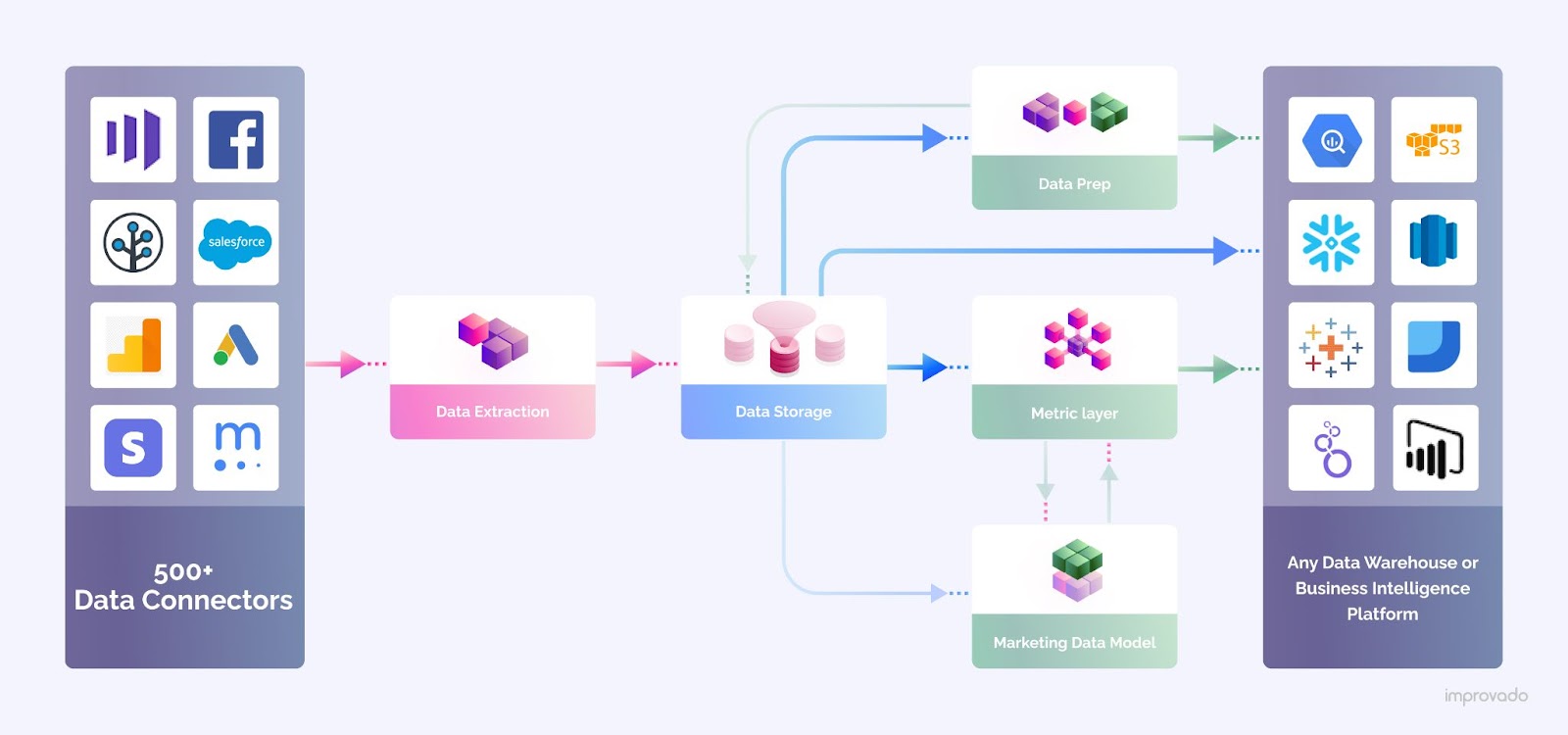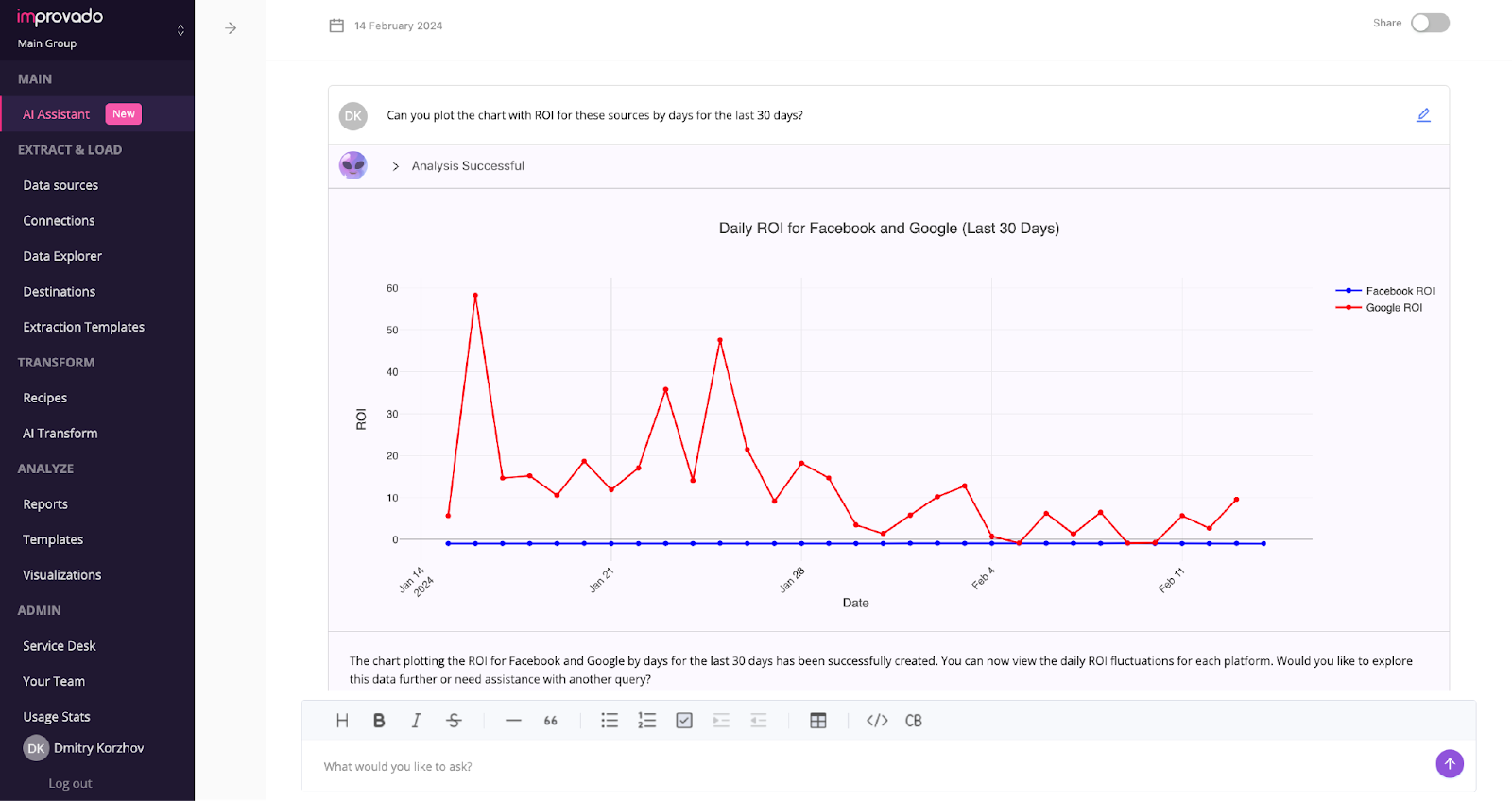The ability to swiftly integrate and analyze data across various sources is essential for maintaining competitive edge and operational efficiency. This article dives into the essence of enterprise data integration, its significance, and how organizations can navigate the complex landscape of integration solutions to bolster their operations and decision-making processes.
What Is Enterprise Data Integration?
By effectively integrating data from various departments, systems, and external sources, enterprises can achieve a holistic view of their operations and market, leading to more informed strategic decisions. The process involves various techniques and technologies, including ETL (extract, transform, load), middleware, and APIs, to ensure seamless data flow and accessibility across the organization. The goal is to break down data silos, improve data quality, and make data more actionable for users across the enterprise.
Key Benefits of Enterprises Data Integration
Enterprise data integration brings numerous benefits to organizations, enhancing their ability to make strategic decisions, streamline operations, and engage with customers effectively.
Key advantages include:
- Improved decision-making: By consolidating data from various sources, enterprises gain a comprehensive view of their business operations, customer behaviors, and market trends, leading to more informed and timely decisions.
- Increased efficiency: Data integration automates the process of collecting, transforming, and loading data across systems, reducing manual effort, and minimizing errors. For instance, ASUS managed to save 80-100 hours a week on manual data by integrating Improvado, a marketing data pipeline and analytics platform.
- Cost reduction: By eliminating redundant data storage and streamlining data processing tasks, data integration can significantly reduce IT and operational costs. Centralized data management minimizes the need for multiple data silos and associated maintenance expenses.
- Enhanced customer experiences: A unified data landscape provides a 360-degree view of the customer journey, enabling personalized marketing strategies, improved customer service, and better product offerings tailored to customer needs.
- Data consistency and quality: Integrating data across the enterprise helps to standardize data formats, definitions, and processes, improving data accuracy and reliability. Consistent data quality is crucial for effective analytics and operational processes. Additionally, it adds up to the cost-saving point. Every year, businesses lose an average of $12.9 million because of low-quality data.
- Scalability: A robust data integration framework can grow with the business, accommodating new data sources, increasing data volumes, and evolving business needs without compromising performance or data integrity.
- Better collaboration: Integrated data fosters collaboration across departments by making shared data easily accessible. This encourages cross-functional teams to work together more effectively, leveraging insights that were previously siloed within specific departments.
Key Enterprise Data Integration Concepts
Enterprise data integration is a complex process. This section delves into the fundamental concepts underpinning this process, from ETL operations and data warehousing to governance and API integration. Each concept plays a distinct role in ensuring data from various sources can be effectively consolidated, analyzed, and utilized to drive business strategies and outcomes.
ETL (Extract, Transform, Load)

ETL stands as a critical process in enterprise data integration, enabling the aggregation of data from multiple, often siloed sources into a single, unified system.
Here's a closer look at each step:
- Extract: The first step involves pulling data from various sources, which might include internal databases, SaaS platforms, cloud storage solutions, or external APIs. This stage is crucial for gathering all relevant data, regardless of its original format or location.
- Transform: Once extracted, the data undergoes transformation to ensure it aligns with the operational requirements of the target system. This includes cleansing data to remove inaccuracies, converting data formats for consistency, normalizing data to ensure uniformity across datasets, and sometimes enriching data by adding additional information or context to make it more valuable.
- Load: The final step is to transfer the transformed data into a target system, such as a data warehouse or data lake, where it is stored and made readily accessible for analysis. This stage is critical for ensuring that the data is correctly positioned in the target environment, maintaining the integrity and structure necessary for effective utilization.
Data warehousing
A data warehouse serves as a centralized repository to consolidate data from diverse sources across an enterprise, facilitating a unified view for analysis. Its architecture is specifically designed to support complex analytical reporting, enabling both structured and ad-hoc queries. This distinct capability allows organizations to perform deep analyses, uncovering insights that drive strategic decision-making.
Data governance
Data governance is a comprehensive framework that ensures data within enterprise systems is managed effectively, focusing on its availability, usability, integrity, and security. This framework sets the policies and procedures for data management, including how data is collected, stored, accessed, and protected. It establishes standards for data quality, ensuring information is accurate, complete, and consistent across the organization.
Data governance also defines roles and responsibilities, assigning specific duties to individuals or teams to oversee data assets, compliance with regulations, and adherence to privacy standards.
By implementing a robust data governance strategy, organizations can maximize the value of their data, minimize risks related to data breaches or non-compliance, and ensure data is leveraged ethically and efficiently in decision-making processes.
Middleware
Middleware plays an essential role in enterprise data integration by serving as the connective tissue between disparate applications and systems within an organization. It facilitates the seamless flow of data across different platforms, databases, and applications, ensuring that these varied systems can communicate and work together effectively. In the context of enterprise data integration, middleware enables the consolidation of data from various sources into a unified view, crucial for comprehensive analysis and decision-making. By providing standardized communication protocols and data formats, middleware ensures data consistency and integrity throughout the integration process.
API (Application Programming Interface)
APIs (Application Programming Interfaces) are pivotal for creating a cohesive data ecosystem. They act as intermediaries that allow disparate software applications, both within and outside an organization, to communicate and exchange data efficiently.
By leveraging APIs, businesses can easily integrate third-party data sources, applications, and services into their existing infrastructure, enhancing their data analysis capabilities. This seamless connectivity facilitated by APIs is crucial for automating data workflows, enabling real-time data access and sharing across various systems.
Master Data Management (MDM)
Master Data Management (MDM) is a strategic approach focused on managing an organization's critical data. It aims to create and maintain a single, consistent set of master data - a canonical dataset that serves as a source of truth for core business entities such as customers, products, employees, and suppliers.
MDM facilitates data accuracy, consistency, and governance across the enterprise by standardizing data definitions, rules, and policies. This process is instrumental in preventing data discrepancies and errors, enhancing data quality, and ensuring reliable data integration and reporting.
The Pillars of Effective Enterprise Integration
Effective enterprise integration rests on several foundational pillars that ensure its success. These pillars address the critical components of integrating various data systems into a cohesive and functional whole.
Data quality management
Data quality management is a critical pillar of effective enterprise data integration, focusing on the accuracy, completeness, and consistency of data across the organization.
Data quality management includes several key activities:
- Data profiling: Analyzing existing data to identify inconsistencies, duplicates, and anomalies
- Data cleaning: Correcting or removing inaccurate, incomplete, or irrelevant data
- Data standardization: Ensuring data adheres to standardized formats and values for consistency across the organization
- Data enrichment: Augmenting existing datasets with additional data from internal or external sources to enhance data completeness and value
- Data monitoring: Continuously tracking data quality over time to identify and rectify emerging issues
- Data governance: Establishing policies and procedures to manage data availability, usability, integrity, and security effectively
Integration methods
Choosing the right integration method depends on the specific needs, data volumes, and the technological infrastructure of an enterprise. Each method has its advantages and considerations, and often, a combination of these approaches is used to achieve comprehensive data integration.
- ETL (Extract, Transform, Load): A foundational method that involves extracting data from source systems, transforming it to meet the target system's requirements, and loading it into the destination database or data warehouse.
- ELT (Extract, Load, Transform): Similar to ETL but with the transformation process occurring after the data is loaded into the data warehouse. This approach leverages the processing power of modern data warehouses to handle complex transformations.
- Data replication: Involves copying data from one location to another in real-time or near real-time, ensuring that multiple systems have consistent and up-to-date information.
- API integration: Uses application programming interfaces to connect different software applications, allowing them to communicate and share data directly.
- Middleware: Acts as a bridge between different systems or databases, facilitating the transfer and translation of data.
Real-time data processing
Real-time data processing is a critical component of enterprise data integration, enabling organizations to analyze and act upon data as it is collected. This approach allows for immediate insights into operational performance, customer behavior, and market trends. In the context of enterprise data integration, real-time processing involves the continuous ingestion and analysis of data streams.
One of the ways to ensure real-time access to data insights for all business users is to leverage AI and natural language analytics. For instance, Improvado AI Agent is a search-driven analytics solution that connects to your marketing dataset and is ready to provide instant insights, following your commands in natural language.

AI Agent is powered by the text-to-SQL technology and writes SQL to find the data you are asking for. With the necessary data retrieved, the system then performs the analysis or presents results in an easily digestible format. AI Agent offers explanations and suggests follow-up questions for further queries to help deepen your understanding of the data.
Security and compliance
Adhering to these practices helps enterprises safeguard their data assets, maintain customer trust, and comply with legal and regulatory standards:
- Data encryption: Securing data at rest and in transit to protect against unauthorized access.
- Access controls: Implementing strict access policies to ensure only authorized personnel can view or manipulate data.
- Audit trails: Keeping detailed logs of data access and changes to track usage and detect potential breaches.
- Regular compliance audits: Periodically reviewing data practices to ensure alignment with industry regulations such as GDPR, HIPAA, and others.
- Data anonymization: Removing or encrypting personal identifiers in datasets to protect individual privacy.
- Security training: Educating staff on data security best practices and potential threats to minimize risks.
Data Integration Solutions: Custom vs. Packaged
When exploring data integration solutions, organizations are often faced with the decision between custom and packaged options. Each path offers distinct advantages and considerations, tailored to meet different business needs and challenges.
Custom solutions
Organizations considering custom solutions must weigh the benefits of a tailored fit against the potential challenges of higher upfront costs and the need for continuous maintenance. This assessment is crucial in determining the most effective path for achieving data integration objectives while aligning with budgetary constraints and long-term strategic goals.
- Tailored fit: Custom solutions are developed to align precisely with an organization's specific data, workflow, and technical requirements. This bespoke approach ensures that the solution integrates seamlessly within the existing data ecosystem, enhancing efficiency and effectiveness.
- Flexibility and scalability: Given their bespoke nature, custom solutions offer unparalleled flexibility, allowing for adjustments, expansions, and modifications as business needs evolve. This adaptability ensures that the solution remains relevant and supportive of growth over time.
- Higher initial investment: The development of custom solutions involves significant upfront investment in terms of time, expertise, and financial resources. The design, development, and deployment phases require careful planning and execution, contributing to the overall cost.
- Long-term maintenance: Beyond the initial setup, custom solutions necessitate ongoing maintenance and updates. As technology advances and business requirements shift, these solutions may require adjustments, adding to the total cost of ownership.
Packaged solutions
When considering packaged solutions for enterprise data integration, organizations must balance the advantages of quick deployment and cost-effectiveness against the potential limitations in customization and the risks associated with vendor dependence.
- Quick deployment: Leveraging pre-built platforms enables organizations to swiftly implement data integration processes. This rapid deployment accelerates the time to value, allowing businesses to capitalize on their data assets without significant delays.
- Cost-effective: With lower upfront costs, packaged solutions present a more accessible entry point for organizations looking to integrate their data systems. The reduced initial investment and setup expenses make these solutions particularly attractive for businesses with limited budgets or those seeking to prove the value of data integration initiatives quickly.
- Limited customization: Despite their ease of implementation and use, packaged solutions may not offer the granularity of customization required to meet the specific demands of an organization's data ecosystem. This limitation can lead to compromises in functionality or efficiency, as the solutions are designed to cater to a broad user base rather than tailored to individual organizational needs.
- Vendor dependence: Opting for a packaged solution often means relying on the vendor for ongoing support, updates, and scalability options. This dependence can pose challenges, particularly if the vendor's roadmap diverges from the organization's evolving needs or if support levels fluctuate.
Types of Enterprise Integration Software
Each type of enterprise integration software has its own set of advantages, catering to different organizational needs based on factors like data sensitivity, regulatory requirements, and scalability demands. Choosing the right platform involves balancing these considerations to align with the company’s overall data strategy and integration objectives.
Here’s a breakdown of the types of enterprise integration software:
- On-premises integration software: This type is installed directly on an organization’s own servers. It provides companies with full control over their integration infrastructure, including data security and compliance. While offering high customization and control, on-premises solutions require a significant investment in hardware, as well as ongoing costs for maintenance and updates.
- Cloud-based integration software (iPaaS): Hosted on the provider's cloud infrastructure, iPaaS solutions offer a flexible and scalable approach to data integration. This model reduces the need for physical hardware investments and simplifies maintenance, providing cost savings and ease of access. iPaaS platforms are ideal for organizations looking to leverage the cloud for integrating various applications and data sources efficiently.
- Hybrid integration platforms: These platforms represent a blend of on-premises and cloud-based solutions, offering the flexibility to address a wide range of integration scenarios. Hybrid platforms are particularly useful for organizations transitioning to the cloud or those with complex integration needs that span across cloud and on-prem environments. They provide the security of on-premises solutions with the scalability and accessibility of cloud services.
Conclusion
Enterprise data integration stands as a pillar of modern operational excellence and strategic agility. By understanding its importance, evaluating solutions carefully, and implementing with foresight and flexibility, organizations can unlock the full potential of their data assets. Start by assessing your current data landscape and integration needs, then explore solutions that align with your operational objectives and strategic vision.
.png)



.png)
